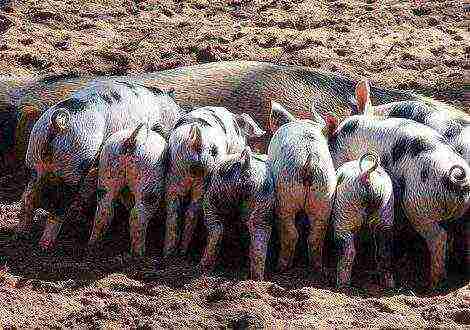Content
- 1 Garden blueberries - the result of the latest breeding work
- 2 Early, mid-late and late ripening varieties
- 3 The most productive varieties for the Moscow region, the Volga region, the non-black earth zone of Russia, the Urals
- 4 Blueberry varieties for Ukraine, Belarus and southern regions of Russia
- 5 Blueberry varieties for Siberia and the Far East
- 6 Winter-hardy varieties adapted to the harshest growing conditions in the Far North
- 7 Video: how to choose a blueberry variety
- 8 Variety for Belarus "Northland"
Tall blueberry is one of the few berry crops introduced in Belarus recently, but it has received such wide recognition. This species differs significantly from the local relative - marsh blueberry, surpassing it in bush height, yield and berry taste. Almost all modern varieties are hybrids obtained from crossing different North American species. After all, tall blueberries are an artificially created culture. In total, more than 250 of its varieties have been bred in the world, classified by the height of the bush, frost resistance, the duration of the dormant period into 5 groups. Three were suitable for our soil and climatic conditions - northern tall, semi-tall and low-growing.
In our country, early-ripening varieties begin to ripen in the first half of July, mid-ripening - in the second, and late-ripening - in the first half of August.
The introduction of useful crops, the creation of their collections and the identification of the most promising taxa for widespread cultivation is one of the main tasks
Of the Central Botanical Garden, in particular, the laboratory for the introduction and technology of berry plants, headed by Nikolai Pavlovsky, Candidate of Biological Sciences. The laboratory was created 30 years ago on the basis of an experimental production plantation of large-fruited cranberries of the Gantsevichi forestry enterprise. It was here, in Gantsevichi, that the first seedlings of the then unknown tall blueberry arrived in 1980. Today the collection of the laboratory has 54 varieties of this culture. The laboratory staff introduced more than 40 taxa of cranberries, more than 50 - blueberries, about 15 - lingonberries, about 10 - edible honeysuckle and other rare berry plants.
- Among 40 varieties and types of vegetables and fruits studied in the USA, it is blueberry that took the leading place in the content of antioxidants, - Nikolai Boleslavovich proudly emphasizes. - It is followed by grape juice, which contains a third less antioxidants, and then strawberries and spinach. Blueberries have 5 times more antioxidants compared to peas, carrots, apples, zucchini. Vitamins A, C, E, anthocyanins, flavonoids, as well as trace elements (zinc, copper, selenium, manganese) contained in its fruits have an antioxidant effect. Plant hormones - phytoestrogens - protect the body from atherosclerosis and heart disease by lowering the level of "bad" cholesterol. Ellagic and folic acids delay the development of neoplasms.Blueberry plant fibers bind carcinogens and heavy metals, facilitating their rapid elimination from the body. The juice has antiviral and antibacterial properties.
There are good natural conditions for blueberries in Belarus. In the central part of the country, the focus should be on mid-season and early varieties, in the south - on early, middle and late varieties. For the north, early maturing varieties, as well as semi-tall and undersized blueberries, are ideal. The culture loves moderately moist, high humus, acidic and light soils. In Belarus, most of these lands are located in the southern part, which is most favorable for blueberries.
- Nikolay Boleslavovich, 2 varieties of semi-tall blueberries - "Northcantry" and "Northblue" are included in the state register. What is the peculiarity of this species?
- The agrotechnology of blueberry cultivation is generally the same. As for semi-tall bushes, then you need to ensure that there is no periodicity of fruiting. In one year they can give 7 - 8 kg per plant, and the next - only 0.5 - 1 kg. And this can only be regulated by cropping. If you see that a lot of flower buds have been laid, without sparing, cut off some of them. The yield may decrease slightly, but the fruits will be much larger. The average yield of a 5-year-old blueberry bush is 2 - 4 kg per plant. Don't try to overload the plant with the crop. This is fraught with the fact that the fruits will be small, sour, and ripen longer and later. And a plant tired of the harvest will lay much fewer flower buds for the next season.
- In the collection of your laboratory there are more than fifty varieties of blueberries. Which of them can be considered promising?
- There are really a lot of varieties. There are both old North American and new ones from other countries and continents. And each has its own strengths and weaknesses. A very large-fruited variety "Toro", no less fruitful are "Spartan" and "Blugold". Large and very sweet berries in the early Hannah Chois variety. The category of outlandish ones include pink-fruited blueberries "Pink lemonade" and "Pink champagne". But these varieties, like Huron, are still licensed. We have the right to study, but not to reproduce for commercial purposes. Huron is one of the newer American varieties. It blooms late, which reduces the risk of damage to flowers by late frosts.
"Berkeley" reproduces easily, unpretentious, but unstable tolerates sharp temperature fluctuations in winter.
"Bluegold" is appreciated because of the late ripening of berries, unpretentiousness, high yield and good taste. "Blue", "Spartan" and "Blue" are resistant to moniliosis, death of branches and mummification of berries. At Darrow, the fruits do not crumble or crack, even in damp weather. Covill often thickens, making pruning difficult. But ripe berries hold tight and do not fall off for a long time. "Nelson" has an irregular, but high yield - up to 5 kg per plant. Moreover, ripe berries also do not crumble for a long time. The Polish variety "Boniface" also showed itself well. It blooms late, after the spring frost in May, which protects the flowers from damage.
Of the New Zealand varieties, Brigitta Blue is considered one of the most promising and highly productive varieties. The berry ripens evenly and does not crumble for a long time. Nui has, perhaps, the largest berries - up to 3.5 g in weight and up to 21 mm in diameter. They ripen in tight clusters resembling bunches of grapes. And the pulp is very dense, "crispy". Even under extreme weather conditions (long rains, drought, significant temperature fluctuations), Puru berries do not lose their quality. The fruits of the "River" do not fall off for a long time either. In addition, this variety is very hardy and disease resistant.
- What varieties are not yet afraid of drought and not very demanding on soil conditions?
“This is Jersey, Hardible. True, their berries are medium-sized. In favor of small-fruited varieties, I want to say that they are much more useful. And all because they have a large area of skin per volume of mass (there is also such a term in gardening).It contains the bulk of biologically active substances. Therefore, blueberries must be eaten with their skins.
- Many people complain that they seem to feed blueberries, but the plant still does not grow. Could the absence of mycorrhiza be the reason and, accordingly, the wrong soil acidity?
- You are right, blueberries are a mycotrophic plant. Its root system is fibrous, densely branched, located in the upper layer (at a depth of 35 - 40 cm) of the soil and does not have root hairs. Under natural conditions, the plant feeds on endotrophic mycorrhiza - a fungus with which it gets along in symbiosis. Blueberry roots begin to grow in spring when the soil warms up to plus 7 degrees, which often coincides with bud opening. At the end of spring, growth stops and resumes again during the period from harvest to leaf fall, until the temperature drops below plus 7 degrees.
Since in nature blueberries grow on the outskirts of raised bogs, there is nothing surprising in the fact that it has a reputation for being undemanding to soil fertility. But very often, many of the nutrients in the soil remain unavailable. This is where mycorrhizal fungi come to the rescue. Mushroom hyphae process organic matter into an easily digestible form and deliver it to the roots of the plant, due to which the blueberry feeds. In addition, fungi provide water and protect plant roots from a variety of disease-causing pathogens. For the normal functioning of mycorrhiza, it is very important to maintain an optimal acidity level - pH 3.5 - 4.5.
And when mycorrhizal mushrooms are good, then blueberries are good too. It grows well on virgin soils, where no agricultural activities have been carried out and no mineral fertilizers and pesticides have been applied. Repeated experiments show that an overdose of mineral fertilizers inhibits mycorrhizal fungi and accelerates the reproduction of others, but already disease-causing ones. Hence the root cancer. Therefore, it is better to underfeed blueberries with mineral fertilizers than overfeeding them.
- And how to apply fertilizers correctly so as not to harm the plant?
- Blueberries are responsive to fertilizing with mineral fertilizers, which are applied in April, May and June. It is best to use acidic forms of fertilizers - "Ammonium sulfate", "Potassium sulfate" and "Superphosphate". For a 2-year-old bush - 1 tbsp. l. full mineral fertilizer, for a 3-year-old - 2, for a 4-year-old - 4, for a 5-year-old - 5. After feeding, the plants must be watered. With a lack of moisture, fertilizers inhibit (!) The plants. This is tantamount to giving a person salt and not giving water.
As for organic fertilizers, they also need to be applied. Especially such as sawdust, wood chips, shavings, bark, high moor peat, forest litter. They should be used when planting blueberries and for mulching the trunk circle during cultivation. This will protect the plants from weeds, retain moisture in the soil, acidify the soil and give it looseness. And most importantly, these organogenic substrates are food for mycorrhizal fungi. You can also use humus, created on the basis of the above substrates. As for fresh manure, chicken manure and other similar fertilizers, they cannot be used primarily for sanitary and hygienic reasons. In addition, they can burn plants.
- In one place, blueberries can grow and bear fruit for up to 100 years. For example, there is a 70-year-old plantation in Poland. What is the guarantee of such longevity?
- In compliance with all the rules of agricultural technology. And first of all, the landing. The planting nest should be wide (at least 1 m in diameter) and shallow - 30 - 40 cm. Since the root system of blueberries is located in the top layer of the soil, make sure that the soil is constantly moist. And at the same time, no prolonged stagnation of water: a lack of air in the soil can lead to the death of plants.
It is best to fill the planting hole with high-moor peat, and if it is not there, with humus based on sawdust and / or peat. The plants are planted at a distance of 1.5 m from each other, and then mulched with a 10 - 15 cm layer of pine sawdust. To acidify the soil, you can use sulfur: 30 g per 1 sq. m twice a season - in spring and autumn. Perfectly acidify soil and coniferous sawdust. Sulfur can be sprayed over sawdust, and then loosened and watered.
Help "SB"
Tall blueberry varieties, zoned in Belarus, - "Bluecrop", "Northland", "Elizabeth", "Erliblu", "Jersey", "Bluetta", "Weymouth", "Denis Blue", "Collins", "Hardible", Northcountry, Duke, Patriot, Northblue.
Soviet Belarus № 175 (24805). Saturday, 12 September 2015
Have you noticed a mistake? Please select it and press Ctrl + Enter
Did you like the material? Rate it.
There are many legends about blueberries: about their growth in swamps, about bears grazing in the neighborhood, and about the content of alcoholic substances in berries. But all this is nothing more than myths, most likely invented by some people to discourage others - competitors who collect fragrant berries on a common forest plot.
Garden blueberries - the result of the latest breeding work
The first series of blueberry varieties for cultivation in gardens were bred by breeders in North America. Berry, having become generally available and changing the place of registration from the northern swamps to cultivated lands, began a march across the continents.
Many novelties of the American-Canadian selection have taken root in the Russian dacha weave. These are mainly tall varieties with a crown up to 2 m. The shrub remained the same frost-hardy, long-lived and inaccessible to pests, as in natural growing conditions, but at the same time increased its yield, and berry picking became possible from the end of July to September.
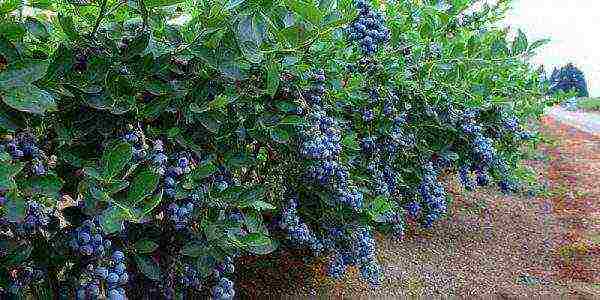
Tall blueberries of Canadian-American selection took root in the dacha plots of Russians
By the timing of ripening, blueberries are divided into:
- early varieties: harvesting begins in the second decade of July;
- mid-late varieties: the harvest ripens in the third decade of July - the first decade of August;
- late varieties: the growing season lasts until half of September, and the harvest is ready for harvest from the second half of August.
Early, mid-late and late ripening varieties
Gardeners should remember that late-ripening shrubs are not suitable for regions with short summers and long winters. So, the climate of the north of Russia, some regions of Siberia and the Far East, where night frosts on the soil can be observed as early as August, will not give blueberries all the conditions necessary for development. The crop, if it has time to ripen, is only in small quantities.
Table: early ripening blueberry varieties
Photo gallery: early blueberry varieties
Table: mid-late blueberry varieties
Photo gallery: mid-late blueberry varieties
Table: late ripening blueberry varieties
Photo gallery: late varieties of blueberries
The most productive varieties for the Moscow region, the Volga region, the non-black earth zone of Russia, the Urals
Speaking about the yield of blueberries, it should be borne in mind that 4 kg of berries from one bush is a common indicator for this crop. But there are also record-breaking varieties that bring simply gigantic yields by the standards of this medium-sized berry. For example, 8-10 kg per bush.
Patriot
The Patriot variety is the result of the selection work of the Agrotechnical Station of New Jersey, USA. The height of the bush can exceed the 2-meter mark. The plant can withstand severe frosts down to -300C, but during spring frosts it can die if measures are not taken in time. Prefers bright glades and moderate moisture. Excellent resistance of the bush to late blight and stem cancer is noted.
More information about the variety in our article - Tall blueberry Patriot: features of the variety and growing rules.
The harvest period is at the end of July. The dark blue ripe berries have an average diameter of 17–18 mm and have a sweet taste. Fruiting is regular.
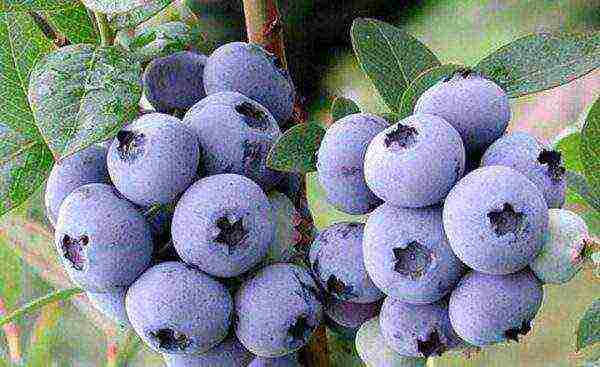
The Patriot variety is very winter-hardy, but does not tolerate spring frosts well.
Spartan
The bush is tall, but not spreading.Erect branches grow up to 2 m. The plant is resistant to pests and tolerates frosts up to -280C, but reacts poorly to stagnant water in the soil.
Spartan is a medium-ripening variety. Fruiting occurs at the end of July. Slightly flattened berries are collected in loose clusters, have a turquoise color, large size (reach 16-18 mm in diameter). The taste is slightly sour and has a pleasant aroma.

Spartan begins to bear fruit from the end of July.
Nelson
Nelson is another fruitful American variety. Late-ripening shrub yields its harvest only at the end of August, therefore, it is completely unsuitable for regions with short summers and early autumn frosts. The height of the bush is 1.5 m.
The fruits have good taste, declared as "wine-sweet". Fragrant large berries in the form of a flattened ball with a diameter of 20 mm hide jelly-like green flesh under the delicate skin.
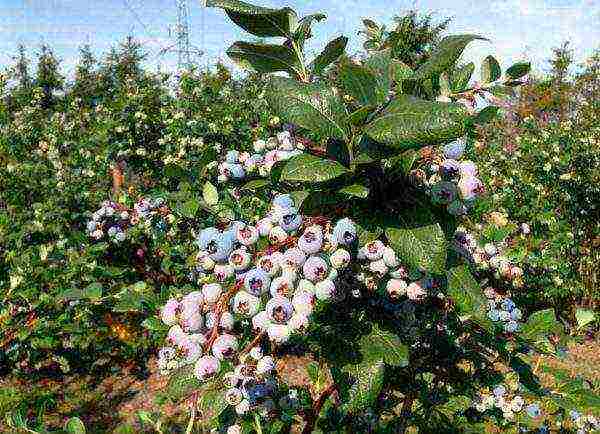
Nelson is not suitable for regions with short summers and early fall frosts
Rankocas
A hybrid variety of tall blueberries that came to eastern Europe from the American continent. A frost-resistant and late blight-resistant bush is capable of forming many shoots, therefore, without high-quality pruning, fruiting will be reduced to small berries.
The dense crown of the shrub is also appreciated as a decoration for hedges.
The harvest ripens in the second decade of August. Fruits are characterized by medium-large size (up to 17 mm in diameter) and flattened shape. The taste is sweet. When ripe, they are not stored on a bush for a long time: they can crack from rain and sun.
Bluecrop
The variety was bred in the state of New Jersey in 1953. It is considered a reference for the temperate climatic zone. It grows up to 2 m in height, but the spreading is small, as the branches grow upward. The shrub is not afraid of frosts down to -350 C, neither a cold spring, nor a dry summer, nor pests. But seasonal pruning is required.
It is characterized by a high annual yield, for which both summer residents and commercial agricultural enterprises love it. Fruit ripening is not uniform, lasts more than a month: from mid-July to late August. The diameter of ripe berries, covered with a pale blue bloom, is 20 mm. The shape is slightly flattened. The taste is exquisitely sweet. Even after freezing, the berries do not lose their rich aroma, sweetness and color. Adapted for transportation.

The Bluecrop shrub is not afraid of frost, cold spring, dry summer, or pests
Blueberry varieties for Ukraine, Belarus and southern regions of Russia
Although traditionally considered a northern berry, blueberries can grow and mature successfully in warm climates. For regions with a long growing season (Ukraine, Belarus, Transcaucasia, the Lower Volga region), acclimatized varieties with both early and medium and late ripening periods are suitable. If you plan correctly at the site of planting blueberries, then in these regions you can feast on it from the beginning of July to the end of September.
Duke
A very popular tall variety for cultivation on summer cottages. The plant is winter-hardy, easily tolerates recurrent frosts, practically does not get sick, begins to bear fruit early, gives a bountiful harvest. There are so many berries on the bushes that the branches bend under their weight. It is important to provide support in time and collect the fruits, otherwise creases on the branches are possible. Fruits have a diameter of 18 to 20 mm, pleasant astringency is felt in the taste. Average yield - up to 8 kg per bush.

The Duke variety easily tolerates recurrent frosts and is not susceptible to diseases.
Chanticleer
The variety is characterized by early maturity. It is considered ideal for commercial cultivation on small plantations, because the crop can be harvested twice a season, and in a mechanized way. The berries are large, 20–22 mm in diameter. Professional tasters called the taste of the berries “wine-fruit”.

Chauntecleer - early maturing variety, great for plantations
Erliblu
A variety of American selection. The shrub is medium-sized.Fruit ripening occurs in two stages: in the first half of July and at the beginning of August. But the second collection is characterized by smaller fruits. The yield ranges from 4 to 7 kg per plant. The berries are 16–18 mm in diameter and slightly sour in taste. They have the property to persist on the branches after ripening for a week. Transportation is poorly tolerated.
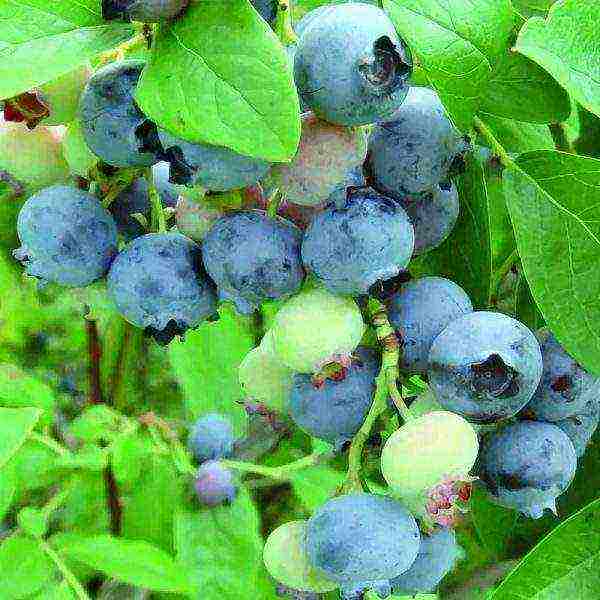
Erliblu produces twice a season
Blue Brigitte
The bush of this variety grows upward and in breadth, gives abundant shoots and is prone to thickening. The plant is sensitive to frost below -250C. Fruiting occurs in mid-August. Ripening of berries is uniform, the yield is high. Fruits up to 15 mm in diameter have a piquant sourness in taste, are not afraid of transportation and long-term storage.
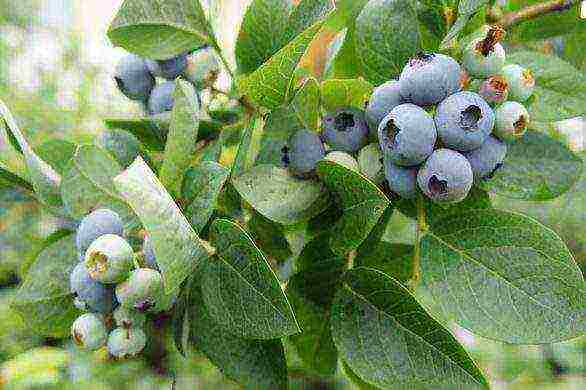
The Blue Brigitte bush grows in breadth and in height
Boniface
The variety was created in Poland, but has taken root well in Belarus, Ukraine and some regions of Russia. It grows quickly and bypasses the 2 m mark. It has ascending branches. The berries are quite large, round in shape, with a spicy taste and aroma. Sufficiently productive variety. Fruiting begins in early August.
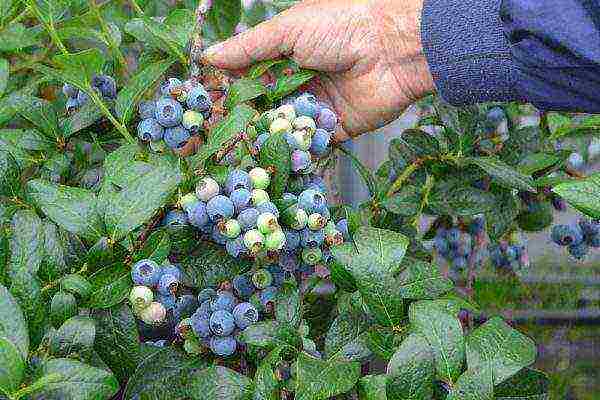
Boniface is a tall variety of Polish selection
Hannah Choice
A tall shrub with branches growing densely upwards. Resistant to frost, even to return frost. Easily withstands temperatures in the spring of -70C. The harvest ripens from mid-August. The berries are 15–17 mm in diameter. The fruits are sweet, can be stored for a long time on branches and in containers.
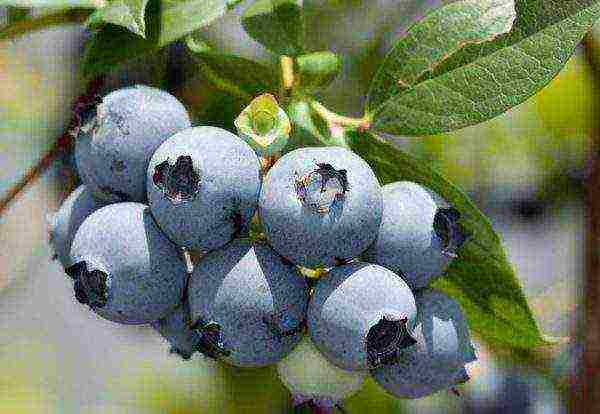
Hannah Choice fruits can be stored for a long time on branches and in containers
Popular varieties of Ukraine, Belarus, southern Russia include Nui, Reku, Toro, Spartan, Bluegold, Covill, Blurey.
Among the new products grown in Ukraine and Belarus are Pink Lemonade and Pink Champagne varieties. They are unusual in that they produce pink berries. The combined taste of sugar honey and lemon acidity made these crops one of the exclusive ones. At the same time, there is no need to create special conditions for them. Plants tolerate moderate frosts well, are disease resistant and are rich in harvest.

Blueberry Pink Lemonade has unusual pink fruits for the culture
Blueberry varieties for Siberia and the Far East
The cool climate of Siberia and the Far East is considered one of the best for growing blueberries. For these areas, almost all of the tall American varieties described above are suitable. But they are not the only ones.
High blueberries included in the State Register of the Russian Federation in 2017
Some varieties of American selection in the State Register of the Russian Federation were registered only in 2017. Accordingly, they have not yet received feedback from practitioners.
- Aurora. Late ripening blueberries 120–150 cm high. Possesses high resistance to diseases and pests. The berries are medium-sized, violet-blue in color. Very sweet in taste, sugar content 15.4%;
- Huron. The bush is not particularly sprawling. The berries are medium in size from 15 to 19 mm in diameter, have a refreshing aroma, slightly sour taste. Stored perfectly. The yield is good, up to 4–5 kg per bush;
- Draper. A hybrid variety created for growing on commercial plantations. The bush is relatively compact, so three plants can fit in an area of 2 m2. The harvest is ready for harvest in July, ripens together. Up to 9 kg of fruits are harvested from one bush;
- Liberty. Blueberries for industrial production and mechanized harvesting. But even on a private backyard, the variety showed itself on a good side, showing high efficiency in the form of a friendly harvest of 7-9 kg per bush. Refers to mid-late varieties.
Photo Gallery: Latest American Blueberry Varieties
Russian bog blueberry
The next group of blueberries is the development of the Novosibirsk Experimental Station, made in the last decade of the 20th century.
Swamp varieties are low-growing, slightly spreading bushes growing on a peat or peat-sand bed.Productivity on bushes up to 100 cm high is considered high if up to 2–2.5 kg per plant is harvested.
The gray berry, recommended for cultivation throughout the territory of Russia, has especially clearly revealed itself in the zone of the Siberian and Far Eastern climate. This group includes the following representatives:
- Blue scattering: sugar 5.6%, tasting score 4, yield up to 2 kg;
- Wonderful: sugar 6%, tasting score 4, yield up to 2 kg;
- Graceful: sugar 7.2%, tasting score 4, yield 0.8 kg;
- Iksinskaya: sugar 8.6%, tasting score 5, yield 0.9 kg;
- Nectar: sugar 9.8%, tasting score 5, yield 0.9 kg;
- Taiga beauty: sugar 5%, tasting point 4, yield 2.1 kg;
- Shegarskaya: sugar 5%, tasting score 4.2, yield 1.5 kg;
- Yurkovskaya: sugar 7%, tasting score 4.5, yield 1.3 kg.
Photo gallery: Russian bog blueberry
Winter-hardy varieties adapted to the harshest growing conditions in the Far North
The blueberries growing in the north are not a wonder of the world at all, but a common natural phenomenon. But nevertheless, breeders distinguish into a separate group varieties that are accustomed to frosts below -40C, abundant snow, severe winds, swampy soils and forest-tundra mosses. The growth of such shrubs does not exceed 70 cm, and the taste of early ripening berries has a unique sourness.
The most winter-hardy varieties include:
- Northland. The bush is not tall, but rather branched. Due to the fact that the berries ripen on shoots that reach 1 m in length, the variety is considered abundant in yield: up to 7 kg are harvested from one plant. Berry size - 17 mm in diameter;
- Northblue. The bush is appreciated not only for large fruits up to 18 mm in diameter, but also for decorativeness. The harvest is ready for harvest by the end of July or beginning of August. Collection rate - 2–2.5 kg per plant;
- Northcantry. The compact plant reaches a height of 80 cm. The regular yield is 2 kg of berries per bush. Collection starts in August. The diameter of the berries is 15 mm;
- Northky. The berries of this variety have a pleasant sweet and sour taste and an average size of up to 14 mm in diameter. They ripen in August and may not fall off the branches for a long time. Well stored and transported.
Photo gallery: northern blueberry varieties
Video: how to choose a blueberry variety
Blueberries, traditionally growing well in the cool climates of the northern regions, can now be cultivated in the south. The variety of varieties bred by domestic and foreign breeders allows gardeners to make a choice that optimally takes into account the characteristics of the area in which the culture will grow.
Rate the article:
(6 votes, average: 4.2 out of 5)
Highbush blueberry is one of the few berry crops introduced in Belarus recently, but it has received such wide recognition.
This species differs significantly from the local relative - marsh blueberry, surpassing it in bush height, yield and berry taste. Almost all modern varieties are hybrids obtained from crossing different North American species, says SB.
After all, tall blueberries are an artificially created culture. In total, more than 250 of its varieties have been bred in the world, classified by the height of the bush, frost resistance, the duration of the dormant period into five groups. For our soil and climatic conditions, three turned out to be suitable - northern tall, semi-tall and undersized.
Our early-ripening varieties begin to ripen in the first, mid-ripening - in the second half of July, and late-ripening - in the first half of August.
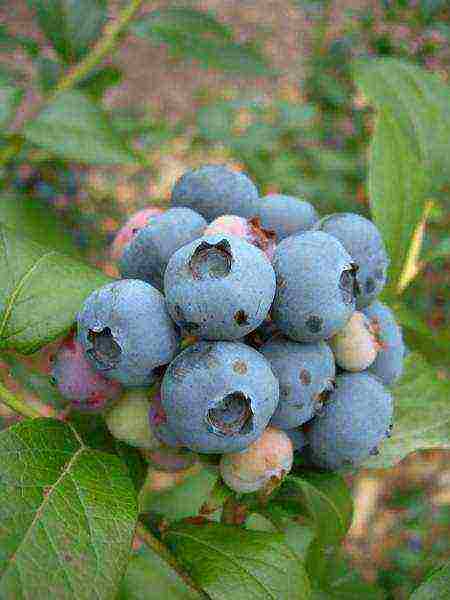
The introduction of useful crops, the creation of their collections and the identification of the most promising taxa for widespread cultivation is one of the main tasks of the Central Botanical Garden, in particular, the laboratory for the introduction and technology of berry plants, headed by the candidate of biological sciences Nikolay Pavlovsky.
The laboratory was created 30 years ago on the basis of an experimental production plantation of large-fruited cranberries of the Gantsevichi forestry enterprise. It was here, in Gantsevichi, that the first seedlings of the then unknown tall blueberry arrived in 1980. Today, the laboratory's collection contains 54 varieties of this culture. The laboratory staff introduced more than 40 taxa of cranberries, more than 50 - blueberries, about 15 - lingonberries, about 10 - edible honeysuckle and other rare berry plants.
- Among 40 varieties and types of vegetables and fruits studied in the USA, it is blueberry that took the leading place in the content of antioxidants, - Nikolai Boleslavovich proudly emphasizes. - It is followed by grape juice, which contains a third less antioxidants, and then strawberries and spinach. Blueberries have five times more antioxidants than peas, carrots, apples, and zucchini. Vitamins A, C, E, anthocyanins, flavonoids, as well as trace elements (zinc, copper, selenium, manganese) contained in its fruits have an antioxidant effect. Plant hormones - phytoestrogens - protect the body from atherosclerosis and heart disease by lowering the level of "bad" cholesterol. Ellagic and folic acids delay the development of neoplasms. Blueberry plant fibers bind carcinogens and heavy metals, facilitating their rapid elimination from the body. The juice has antiviral and antibacterial properties.
There are good natural conditions for blueberries in Belarus. In the central part of the country, the stake should be placed on mid-season and early varieties, in the south - on early, middle and late varieties. For the north, early maturing varieties, as well as semi-tall and undersized blueberries, are ideal. The culture loves moderately moist, high humus, acidic and light soils. In Belarus, most of these lands are located in the southern part, which is most favorable for blueberries.
- Nikolay Boleslavovich, the state register includes two varieties of semi-tall blueberries - "Northcantry" and "Northblue". What is the peculiarity of this species?
- The agrotechnology of blueberry cultivation is generally the same. As for semi-tall bushes, then you need to ensure that there is no periodicity of fruiting. In one year they can give 7-8 kg per plant, and the next - only 0.5-1 kg. And this can only be regulated by cropping. If you see that a lot of flower buds have been laid, without sparing, cut off some of them. The harvest may decrease a little, but the fruits will be much larger. The average yield of a five-year-old blueberry bush is 2-4 kg per plant. Don't try to overload the plant with the crop. This is fraught with the fact that the fruits will be small, sour, and ripen longer and later. And a plant tired of the harvest will lay much fewer flower buds for the next season.
- In the collection of your laboratory there are more than fifty varieties of blueberries. Which of them can be considered promising?
- There are really a lot of varieties. There are both old North American and new ones from other countries and continents. And each has its own strengths and weaknesses. A very large-fruited variety "Toro", no less productive are "Spartan" and "Bluegold". The early Hanna Chois variety has large and very sweet berries. The category of outlandish ones include pink-fruited blueberries "pink lemonade" and "pink champagne". But these varieties, like Huron, are still licensed. We have the right to study, but not to reproduce for commercial purposes. Huron is one of the newer American varieties. It blooms late, which reduces the risk of damage to flowers by late frosts.
"Berkeley" reproduces easily, unpretentious, but unstable tolerates sharp temperature fluctuations in winter.
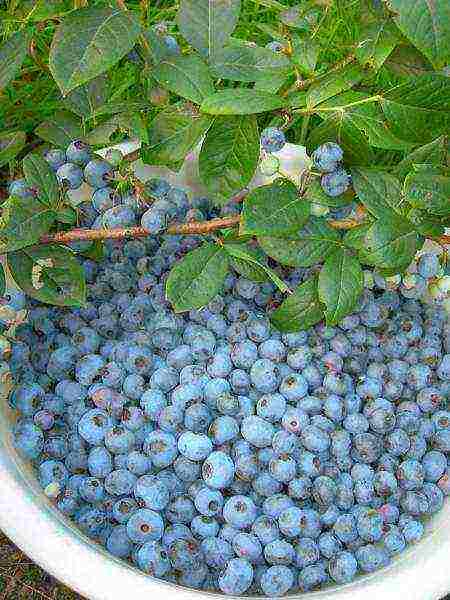
"Bluegold" is appreciated because of the late ripening of berries, unpretentiousness, high yield and good taste. "Blue", "Spartan" and "Blue" are resistant to moniliosis, death of branches and mummification of berries.Darrow's fruits do not crumble or crack even in damp weather. Covill often thickens, making pruning difficult. But ripe berries hold tightly and do not fall off for a long time. "Nelson" has an irregular, but high yield - up to 5 kg per plant. Moreover, ripe berries do not crumble for a long time either. The Polish variety "Bonifaces" also showed itself well. It blooms late, after the spring frost in May, which protects the flowers from damage.
Of the New Zealand varieties, Brigitta Blue is considered one of the most promising and highly productive varieties. The berry ripens evenly and does not crumble for a long time. Nui has, perhaps, the largest berries - up to 3.5 g in weight and up to 21 mm in diameter. They ripen in tight clusters resembling bunches of grapes. And the pulp is very dense, "crispy". Even under extreme weather conditions (prolonged rains, drought, significant temperature fluctuations), Puru berries do not lose their quality. For a long time, the fruits do not fall off the “river” either. In addition, this variety is very hardy and disease resistant.
- What other varieties are not afraid of drought and are not very demanding on soil conditions?
- This is "jersey", "hardible". True, their berries are medium-sized. In favor of small-fruited varieties, I want to say that they are much more useful. And all because they have a large area of skin per volume of mass (there is also such a term in gardening). It contains the bulk of biologically active substances. Therefore, blueberries must be eaten with their skins.
- Many people complain that they seem to feed blueberries, but the plant still does not grow. Could the absence of mycorrhiza be the reason and, accordingly, the wrong soil acidity?
- You are right, blueberries are a mycotrophic plant. Its root system is fibrous, densely branched, located in the upper layer (at a depth of 35-40 cm) of the soil and has no root hairs. Under natural conditions, the plant feeds on endotrophic mycorrhiza - a fungus with which it gets along in symbiosis. Blueberry roots begin to grow in spring when the soil warms up to plus 7 degrees, which often coincides with bud opening. At the end of spring, growth stops and resumes again during the period from harvest to leaf fall, until the temperature drops below plus 7 degrees.
Since in nature blueberries grow on the outskirts of raised bogs, there is nothing surprising in the fact that it has a reputation for being undemanding to soil fertility. But very often, many of the nutrients in the soil remain unavailable. This is where mycorrhizal fungi come to the rescue. Mushroom hyphae process organic matter into an easily digestible form and deliver it to the roots of the plant, due to which the blueberry feeds. In addition, fungi provide water and protect plant roots from a variety of disease-causing pathogens. For the normal functioning of mycorrhiza, it is very important to maintain an optimal acidity level - pH 3.5-4.5.
And when mycorrhizal mushrooms are good, then blueberries are good too. It grows well on virgin soils, where no agricultural activities have been carried out and no mineral fertilizers and pesticides have been applied. Repeated experiments show that an overdose of mineral fertilizers inhibits mycorrhizal fungi and accelerates the reproduction of others, but already disease-causing ones. Hence the root cancer. Therefore, it is better to underfeed blueberries with mineral fertilizers than overfeeding them.
- And how to apply fertilizers correctly so as not to harm the plant?
- Blueberries are responsive to fertilizing with mineral fertilizers, which are applied in April, May and June. It is best to use acidic forms of fertilizers - ammonium sulfate, potassium sulfate and superphosphate. For a 2-year-old bush - 1 tbsp. l. full mineral fertilizer, for a 3-year-old - 2, for a 4-year-old - 4, for a 5-year-old - 5. After feeding, the plants must be watered. With a lack of moisture, fertilizers inhibit (!) The plants.This is tantamount to giving a person salt and not giving water.
As for organic fertilizers, they also need to be applied. Especially such as sawdust, wood chips, shavings, bark, high moor peat, forest litter. They should be used when planting blueberries and for mulching the trunk circle during cultivation. This will protect the plants from weeds, retain moisture in the soil, acidify the soil and give it looseness. And most importantly, these organogenic substrates are food for mycorrhizal fungi. You can also use humus, created on the basis of the above substrates. As for fresh manure, chicken manure and other similar fertilizers, they cannot be used, primarily for sanitary and hygienic reasons. In addition, they can burn plants.
- In one place, blueberries can grow and bear fruit for up to 100 years. For example, there is a 70-year-old plantation in Poland. What is the guarantee of such longevity?
- In compliance with all the rules of agricultural technology, and first of all - planting. The planting nest should be wide (at least 1 m in diameter) and shallow - 30-40 cm. Since the root system of blueberries is located in the upper soil layer, make sure that the soil is constantly moist. And at the same time, no prolonged stagnation of water: a lack of air in the soil can lead to the death of plants.
It is best to fill the planting hole with high-moor peat, and if it is not there, with humus based on sawdust and / or peat. Plants are planted at a distance of 1.5 m from each other, and then mulched with a 10-15-centimeter layer of sawdust from the needles. To acidify the soil, you can use sulfur: 30 g per 1 sq. m twice a season - in spring and autumn. Perfectly acidify soil and coniferous sawdust. Sulfur can be sprayed over sawdust, and then loosened and watered.
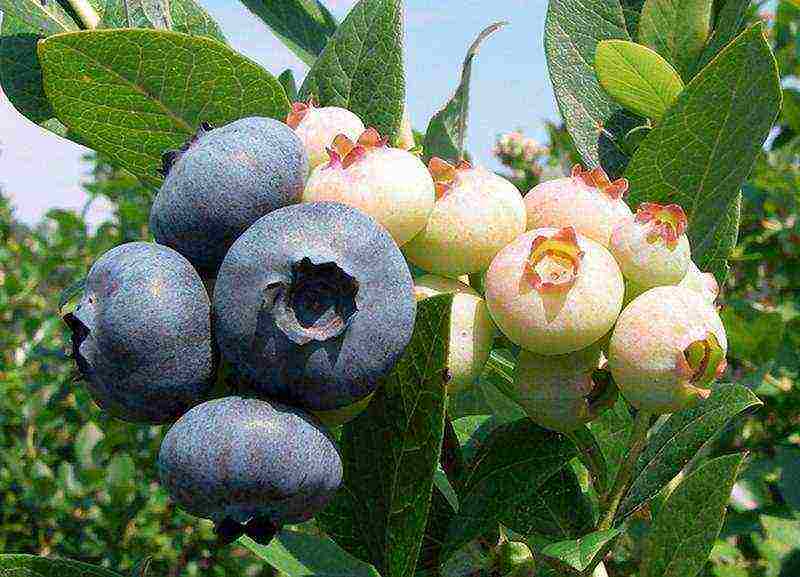
Reference:
Tall blueberry varieties, zoned in Belarus - "bluecrop", "northland", "elizabeth", "erliblu", "jersey", "bluetta", "weymouth", "denis blue", "collins", "hardible", Northcountry, duke, patriot, northblue.
Natalia TYSHKEVICH
To leave a comment, you must be logged in.
How not to miscalculate and choose a blueberry variety for rich fruiting? Read in today's article about the best varieties of garden blueberries for Belarus.
Garden blueberry varieties in Belarus
For fruiting all year round you need not only the desire to get a harvest, but also a combination of related factors: weather, a successful variety, cultivated soil. Belarus is famous for heather plants, and blueberry - one of the many options for berries that are picked and harvested from the garden. Despite the boggy and high acidity of the sites and the lack of popular crops, summer residents in Belarus have found a use for their land: planting blueberries. If the situation is different on your site: how to oxidize the soil for blueberries? We propose to consider in detail what varieties of garden blueberries are in demand in Belarus?
Blueberry varieties for the garden in Belarus:
- Low-growing: Bluegold, Northland.
- Tall: Blucrop, Erliblu, Bluetta, Patriot, Duke.
"Bluegold" - a variety of medium bush height: from 1.2 to one and a half meters. Yields 5-7 kg per bush and ripens by mid-July. Not a bad option for landing on evil frost. Medium berries - up to 16 mm in diameter.
Minus: stale or even "shrink" at elevated temperatures; besides, the bush is spreading. If you remove the berries in time and use them in homemade preparations or get enough vitamins on fresh traces, you will not notice any problems.
Variety for Belarus "Northland"
The variety is truly northern (even if translated), as it can withstand a drop in temperature up to -40° C! It bears fruit often and a lot, the berries are bluish with a purple tint - it is interesting to use both in fresh recipes, as well as in homemade preparations (jams, preserves, confitures). Yields up to 4 kg per bush. Does not suffer from typical blueberry problems, increased resistance to parasites.Bushes are low, wide - you can form hedges.
Fruiting: second half of July. If you have problems: Why does garden blueberry not bear fruit?
A variety of tall blueberries for Belarus "Bluecrop»
An American variety that, unlike the "eyes", takes root without problems. It grows up to 2 m, the shoots stretch upwards. The berries are large enough: 20 mm each, blue, with a characteristic bloom. The pulp is juicy and tasty.
When it blooms: May to June.
Ripens: July-August.
The variety is frost-resistant - it withstands 30-degree frosts before flowering, and about 7-10 degrees in time.
Suitable for any kind of homework.
Nuances: trimming is needed.
Variety "Erliblu»
A bright variety of garden blueberries in Belarus. The bush grows up to 1.3-1.9 m. It is excellent to branch, it needs regular pruning, as it grows a lot of buds.
When it ripens: first half of July.
Yields an average bush yield. Each berry is up to 18 mm in diameter, of a more intense, bluish shade with a less pronounced whitish coating. The berries are dense - retain their shape during transportation.
Pros: leader in frost resistance.
Blueberry variety for Belarus "Bluetta»
The variety is popular not only for Belarus - it is also planted in the Moscow region. In general, "Bluetta" is an excellent, wide bush up to 1 m.
When it ripens: in the first half of July.
Fruiting more than others - 9 kg per bush. The berries are tastier than the previous versions, with dense flesh. The color is deep blue with a whitish veil underneath. Best consumed fresh.
Pros: beautiful, frost-resistant, delicious.
«Patriot"- blueberry variety for Belarus
A patriot of America or Belarus - it doesn't matter. Garden blueberry variety "Patriot" perfectly adapts to the cold, resistant to late blight, grows up to 1.8 m in height. If you saw that the berries are red, they have not yet ripened, since at 100% readiness the color of the Patriot is dark blue.
Pros: resistant, reproduces well, decorative.
Cons: need protection against typical blueberry diseases, ripens from mid-July.
Garden blueberry variety "Duke"For Belarus
Pamper yourself excellent taste of late variety for open ground in Belarus. What sort of blueberry for the Moscow region is better to plant? "Duke", like his boyfriend, is resistant to any twists and turns, gives about 8 kg per bush, and berries - an incredible aroma - forms light blue, sweet, juicy.
Pros: resistant to disease and frost.
Cons: matures by the end of July, constant lighting is needed.
↓ We are waiting for comments on your favorite varieties of garden blueberries for Belarus.
Please rate the material you have read :)
(No ratings yet)
READ ALSO:
